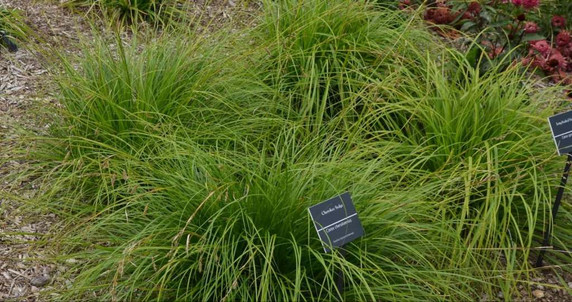
Carex cherokeensis - CHEROKEE SEDGE
"Add Cherokee Sedge to your list of great North American native grasses. Carex cherokeensis serves as a foundation in the landscape, particularly in meadow gardens, rain gardens, ground covers, natural areas, and in alternatives to traditional plantings. It’s a workhorse, too. Cherokee Sedge can handle sun, preferring some shade; it likes moist conditions, yet, it also tolerates average soils. The rich green, arching foliage spreads slowly in well-behaved clumps—a verdant companion to woodland perennials. It is similar to C. pensylvanica, but is a little larger with a coarser texture. Flowers are small, but the wheat-like seed spikes that follow gracefully droop and add interest in spring. Found primarily in lower Southeast U.S." Hoffman Nursery
One of the top performers at Mt. Cuba Carex trials, gaining 4.7 points for shade use and 4.3 for use in sunny areas (out of 5).
Semi-evergreen clumps with medium texture. Doesn't respond well to mowing or deep cutting - so clean up gently in pre-spring and don't cut too deep.
Blooming Time: April/May
USDA Zones: 6 to 9
Culture: sun, half shade, dappled shade, shade, full sun plantings shouldn't be in dry soil. Medium-moist (average) to wet soils with some organic matter.
Moisture Needs: Average moisture (medium) to wet soils.
Origin: Native to southeastern and southern part of USA (including the deep south and Texas), see the BONAP distribution map. Often found on sandy loams in the wodland edges, stream areas, moist soils.
Deer/Rabbit Resistant: yes / yes
Black Walnut Tolerant: yes
Attracts Butterflies or Pollinators: yes/yes. Host plant for larvae of Satyr butterfly.
Attracts Hummingbirds/birds/other animals: no / attracts small birds, provides shelter and nesting material to small animals.
Plant combinations: Use this sedge as a filler, from small groups to masses, as a ground sedge or matrix plant, or as the lawn substitute. Best in part shade or on moist soisl, rain gardens, moist spots, in difficult shaded and moist areas, sunken moist areas, along water bodies (streams, margins)
Great combined with many perennials in half shade or half sun with adequate moisture. In moister soil it goes well with Amsonia, Asclepias incarnata, Boltonia asteroides, Caltha palustris, Chelone, Coreopsis palustris 'Summer Sunshine', Eupatorium - better with shorter forms (including Eupatorium -Conoclinum coelestis), Euphorbia palustris, herbaceous Hibiscus, moisture loving Irises (I. sibirica, I. laevigata, I. pseudata, I. x lousiana, I. virginica, I. versicolor and others), Ligularia, Lobelia siphilita, Lobelia cardinalis, Packera aurea, Persicaria, Phlox maculata and Phlox paniculata, Physostegia, Primula, Sanquisorba, Senna, Zizia, and various ferns!
In half shade/shade with average to slightly moist soil goes well with Hosta, Bergenia, Brunnera, hardy Geraniums, Heuchera & Heucherella, Mertensia, Tiarella.
Pot Size: square 3.5" x 4" deep pot
Pictures copyright: Mt. Cuba Center

Carex cherokeensis - CHEROKEE SEDGE
"Add Cherokee Sedge to your list of great North American native grasses. Carex cherokeensis serves as a foundation in the landscape, particularly in meadow gardens, rain gardens, ground covers, natural areas, and in alternatives to traditional plantings. It’s a workhorse, too. Cherokee Sedge can handle sun, preferring some shade; it likes moist conditions, yet, it also tolerates average soils. The rich green, arching foliage spreads slowly in well-behaved clumps—a verdant companion to woodland perennials. It is similar to C. pensylvanica, but is a little larger with a coarser texture. Flowers are small, but the wheat-like seed spikes that follow gracefully droop and add interest in spring. Found primarily in lower Southeast U.S." Hoffman Nursery
One of the top performers at Mt. Cuba Carex trials, gaining 4.7 points for shade use and 4.3 for use in sunny areas (out of 5).
Semi-evergreen clumps with medium texture. Doesn't respond well to mowing or deep cutting - so clean up gently in pre-spring and don't cut too deep.
Blooming Time: April/May
USDA Zones: 6 to 9
Culture: sun, half shade, dappled shade, shade, full sun plantings shouldn't be in dry soil. Medium-moist (average) to wet soils with some organic matter.
Moisture Needs: Average moisture (medium) to wet soils.
Origin: Native to southeastern and southern part of USA (including the deep south and Texas), see the BONAP distribution map. Often found on sandy loams in the wodland edges, stream areas, moist soils.
Deer/Rabbit Resistant: yes / yes
Black Walnut Tolerant: yes
Attracts Butterflies or Pollinators: yes/yes. Host plant for larvae of Satyr butterfly.
Attracts Hummingbirds/birds/other animals: no / attracts small birds, provides shelter and nesting material to small animals.
Plant combinations: Use this sedge as a filler, from small groups to masses, as a ground sedge or matrix plant, or as the lawn substitute. Best in part shade or on moist soisl, rain gardens, moist spots, in difficult shaded and moist areas, sunken moist areas, along water bodies (streams, margins)
Great combined with many perennials in half shade or half sun with adequate moisture. In moister soil it goes well with Amsonia, Asclepias incarnata, Boltonia asteroides, Caltha palustris, Chelone, Coreopsis palustris 'Summer Sunshine', Eupatorium - better with shorter forms (including Eupatorium -Conoclinum coelestis), Euphorbia palustris, herbaceous Hibiscus, moisture loving Irises (I. sibirica, I. laevigata, I. pseudata, I. x lousiana, I. virginica, I. versicolor and others), Ligularia, Lobelia siphilita, Lobelia cardinalis, Packera aurea, Persicaria, Phlox maculata and Phlox paniculata, Physostegia, Primula, Sanquisorba, Senna, Zizia, and various ferns!
In half shade/shade with average to slightly moist soil goes well with Hosta, Bergenia, Brunnera, hardy Geraniums, Heuchera & Heucherella, Mertensia, Tiarella.
Pot Size: square 3.5" x 4" deep pot
Pictures copyright: Mt. Cuba Center











